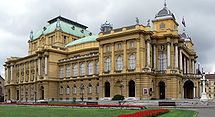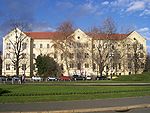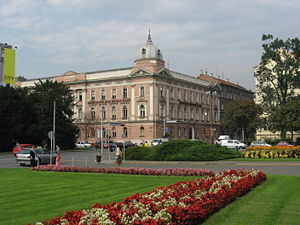
Marshal Tito Square
Encyclopedia



Zagreb
Zagreb is the capital and the largest city of the Republic of Croatia. It is in the northwest of the country, along the Sava river, at the southern slopes of the Medvednica mountain. Zagreb lies at an elevation of approximately above sea level. According to the last official census, Zagreb's city...
, Croatia
Croatia
Croatia , officially the Republic of Croatia , is a unitary democratic parliamentary republic in Europe at the crossroads of the Mitteleuropa, the Balkans, and the Mediterranean. Its capital and largest city is Zagreb. The country is divided into 20 counties and the city of Zagreb. Croatia covers ...
. The square is located in Lower Town
Donji Grad
Donji grad is one of the 17 city districts of Zagreb, the capital of Croatia. It is located in the central part of the city and has 45,108 inhabitants . The official name of the district is rarely used, for it is dubbed centar by most of the Zagreb residents....
, with the Croatian National Theatre building at its centre. It is sometimes billed as the "most beautiful square in Zagreb".
The present-day square was formed in the period between 1856 (when the former hospital was built on its northern side) and 1964 (when the Ferimport building was erected on the western side). However, the majority of buildings overlooking the square were built in the late 19th century in the historicist
Historicism (art)
Historicism refers to artistic styles that draw their inspiration from copying historic styles or artisans. After neo-classicism, which could itself be considered a historicist movement, the 19th century saw a new historicist phase marked by a return to a more ancient classicism, in particular in...
style of architecture.
Marshal Tito square was the first in line of three squares which form the west wing of the so-called Lenuci's horseshoe , a U-shaped belt of squares and parks designed by engineer Milan Lenuci in the late 19th century which frames the core part of Zagreb's city centre. The east wing of the belt is formed by the King Tomislav, Strossmayer and Zrinski
Nikola Šubić Zrinski Square
Nikola Šubić Zrinski Square is a square and park in Donji Grad, the central part of Zagreb, the capital of Croatia. It is located near the central Ban Jelačić Square, halfway towards the Main Railway Station. It is a part of the so-called Green horseshoe or Lenuzzi's horseshoe , which consists of...
squares, and the west wing by the Marulić, Mažuranić and Marshal Tito squares, with the Botanical Garden connecting the two. The square is home to several cultural and educational institutions and several landmark sculptures.
Timeline
- 1855–1856 - The square begins to take shape with the first building constructed on its northern side, a hospital ran by Daughters of Charity. From 1868 to 1882 the building housed a tobacco factory, and when the factory was moved out in 1882 it was taken over by the University of ZagrebUniversity of ZagrebThe University of Zagreb is the biggest Croatian university and the oldest continuously operating university in the area covering Central Europe south of Vienna and all of Southeastern Europe...
. Today it houses the Zagreb Faculty of Law and the university rectorate. It was designed by architect Ludwig von Zettl. - 1864 - The area of the present-day square is used as a fair ground for the first trade fair held in Croatia, the First Dalmatian-Croatian-Slavonian Trade Exhibition , which was opened by banBan (title)Ban was a title used in several states in central and south-eastern Europe between the 7th century and the 20th century.-Etymology:The word ban has entered the English language probably as a borrowing from South Slavic ban, meaning "lord, master; ruler". The Slavic word is probably borrowed from...
Josip ŠokčevićJosip ŠokcevicBaron Josip Šokčević , was a Croatian viceroy , lieutenant marshal and governor of the Serbian Voivodship and Banat of Temeschwar.-Life:...
and attended by more than 3,000 companies from throughout Croatia and the Austrian EmpireAustrian EmpireThe Austrian Empire was a modern era successor empire, which was centered on what is today's Austria and which officially lasted from 1804 to 1867. It was followed by the Empire of Austria-Hungary, whose proclamation was a diplomatic move that elevated Hungary's status within the Austrian Empire...
. - 1874 - The building which today houses the Školska knjigaŠkolska knjigaŠkolska knjiga is one of the largest publishing companies in Croatia. It was established in 1950. Until the mid-1990s it had a virtual monopoly on publishing schoolbooks and this remains its core business....
publishing company is built on the eastern side. Designed by Janko Jambrišak, it went through several renovations and modifications since then. - 1876–1878 - A two-story house designed by Franjo KleinFranjo KleinFranjo Klein was one of the most important architects in the period of an early and mature historicism in Croatia and the most prominent architect in Zagreb in the 1860s and 1870s.-Early work in Vienna and Bjelovar:...
is built on the eastern side, originally as the headquarters of the Croatian chamber of commerce (Hrvatsko gospodarsko društvo). In 1922 a third floor was added; today it is part of the Faculty of Law. - 1884 - The southern side of the square is closed, through the construction of the building which housed the SokolSokolThe Sokol movement is a youth sport movement and gymnastics organization first founded in Czech region of Austria-Hungary, Prague, in 1862 by Miroslav Tyrš and Jindřich Fügner...
gymnasticsGymnasticsGymnastics is a sport involving performance of exercises requiring physical strength, flexibility, agility, coordination, and balance. Internationally, all of the gymnastic sports are governed by the Fédération Internationale de Gymnastique with each country having its own national governing body...
society and the Kolo folklore group. A revised design by architect Matija Antolec was used for the building. The west wing was added during the construction of the Croatian National Theatre 11 years later, which was originally used for storing theatre props (today it houses a spare balet hall, art workshops and heating systems for the theatre building). In 1969 the west wing was connected to the theatre via an underground tunnel. The rest of the building today houses the Academy of Dramatic ArtAcademy of Dramatic Art, University of ZagrebThe Academy of Dramatic Art is a Croatian drama and film school. It is one of the three art academies affiliated with the University of Zagreb, along with the Academy of Fine Arts and Academy of Music...
. - 1888 - The building housing the School of Crafts (Obrtna škola, today the School of Applied Arts and Design) and the Museum of Arts and Crafts is built on the western side, designed by architect Hermann BolléHermann BolléHermann Bollé was an Austrian architect specialized in Church architecture who worked in Croatia.Bollé was born in Köln. He worked on the Cathedral in Đakovo, restored the Zagreb cathedral after the 1880 earthquake, restored Križevci cathedral from 1895-1897, designed the main building of the...
. - 1889 - Eastern side takes its final form with the building of the Teacher's Association (Učiteljski dom, today the Croatian School Museum), designed by Leo Hönigsberg of the Hönigsberg & DeutschHönigsberg & DeutschHönigsberg & Deutsch was an architecture studio and construction company formed in Zagreb by architects Leo Hönigsberg and Julio Deutsch, active between 1889 and 1911. They produced over 90 known works in the Lower Town area of Zagreb, built during the redevelopment in the years following the 1880...
architecture studio. - 1891 - A two-story building built on the northwest corner, designed by Kuno Waldmann (today home of the Miroslav Krleža Lexicographical InstituteMiroslav Krleža Lexicographical InstituteThe Miroslav Krleža Lexicographical Institute is Croatia's national lexicographical institution. Based in Zagreb, it was originally established in 1950 as the national lexicographical institute of the Socialist Federal Republic of Yugoslavia...
). - 1895 - The new building of the Croatian National Theatre designed by Fellner & Helmer opens (the theatre moves here from its old location in the Old City HallOld City Hall (Zagreb)The Old City Hall is a complex of three adjacent buildings located in the Gradec neighbourhood in Zagreb, Croatia. The three buildings were joined in the late 19th century and since then, the complex has served as the place where all sessions of the city assembly are held.-History:The earliest...
in GradecGradec, ZagrebGradec or Grič is a part of the Zagreb, Croatia, and together with Kaptol it is the mediaeval nucleus of the city. It's situated on the hill of Gornji Grad.- History :Gradec was given a royal charter by King Bela IV in 1242...
). The inauguration is attended by Emperor Franz JosephFranz Joseph I of AustriaFranz Joseph I or Francis Joseph I was Emperor of Austria, King of Bohemia, King of Croatia, Apostolic King of Hungary, King of Galicia and Lodomeria and Grand Duke of Cracow from 1848 until his death in 1916.In the December of 1848, Emperor Ferdinand I of Austria abdicated the throne as part of...
and marked by a student protest who burned the Austrian flag at Ban Jelačić SquareBan Jelacic SquareBan Jelačić Square is the central square of the city of Zagreb, Croatia, named after ban Josip Jelačić. The official name is Trg bana Jelačića...
(as the theatre was built during the reign of banBan (title)Ban was a title used in several states in central and south-eastern Europe between the 7th century and the 20th century.-Etymology:The word ban has entered the English language probably as a borrowing from South Slavic ban, meaning "lord, master; ruler". The Slavic word is probably borrowed from...
Károly Khuen-HéderváryKároly Khuen-HéderváryDragutin Károly Khuen-Héderváry, also known as Károly Count Khuen-Héderváry de Hédervár , was a Hungarian politician, the ban of Croatia in the late nineteenth century. He succeeded the temporary reign of Ban Hermann Ramberg in 1883. Khuen's reign was marked by a strong magyarization...
and the project was seen as part of his MagyarizationMagyarizationMagyarization is a kind of assimilation or acculturation, a process by which non-Magyar elements came to adopt Magyar culture and language due to social pressure .Defiance or appeals to the Nationalities Law, met...
policies). - 1899 - A two-story house built on the eastern side, designed by Martin Pilar. In 1922 the building was reconstructed and a third floor and a mansard roofMansard roofA mansard or mansard roof is a four-sided gambrel-style hip roof characterized by two slopes on each of its sides with the lower slope at a steeper angle than the upper that is punctured by dormer windows. The roof creates an additional floor of habitable space, such as a garret...
were added, based on the designs by Oton Goldscheider. Today it houses the Kazališna kavana (EnglishEnglish languageEnglish is a West Germanic language that arose in the Anglo-Saxon kingdoms of England and spread into what was to become south-east Scotland under the influence of the Anglian medieval kingdom of Northumbria...
: Theatre Cafe). - 1903 - SecessionistVienna SecessionThe Vienna Secession was formed in 1897 by a group of Austrian artists who had resigned from the Association of Austrian Artists, housed in the Vienna Künstlerhaus. This movement included painters, sculptors, and architects...
-style building erected on the southwest corner, designed by Vjekoslav BastlVjekoslav BastlVjekoslav "Alojz" Bastl was a Croatian architect known for his diverse secessionist architectural style. His work circulated mostly within the boundaries of Zagreb, where he resided. Later in life, he got heavily influenced by modernism....
for Hönigsberg & Deutsch - 1911–1912 - The northern part of the square undergoes redecoration, designed by Ignjat Fischer. Obelisk-shaped candelabra which were built in front of the National Theatre moved to the Mirogoj cemeteryMirogoj CemeteryThe Mirogoj Cemetery is considered to be one of the most beautiful cemetery parks in Europe and, because of its design, numbers among the more noteworthy landmarks in the City of Zagreb....
and Ivan MeštrovićIvan MeštrovicIvan Meštrović was a Croatian and Yugoslav sculptor and architect born in Vrpolje, Croatia...
's sculpture Well of Life was installed in its place. - 1913 - East of the Kolo building, Frank House was erected, designed by Viktor KovačićViktor KovacicViktor Kovačić was a Croatian architect. His projects are marked with subtle purity of reduced elements of historicism, like in monumental Stock Exchange Palace in Zagreb, 1924...
in the Renaissance Revival style - 1964 - The Željpoh building (later known as Ferimport building) built on the western side, designed by Stanko Fabris. Currently being renovated and is expected to house the Zagreb Academy of Music upon completion in 2011.
Former names
Being one of the most prominent squares in Zagreb its name was often changed in accordance to political circumstances of the time, and the issue is still somewhat controversial as some citizens' groups are lobbying for another name change on the grounds that Josip Broz TitoJosip Broz Tito
Marshal Josip Broz Tito – 4 May 1980) was a Yugoslav revolutionary and statesman. While his presidency has been criticized as authoritarian, Tito was a popular public figure both in Yugoslavia and abroad, viewed as a unifying symbol for the nations of the Yugoslav federation...
is a negative historical personality, due to his involvement in atrocities such as the Bleiburg massacre
Bleiburg massacre
The Bleiburg massacre, which also encompasses Operation Keelhaul is a term encompassing events that took place during mid-May 1945 near the Carinthian town of Bleiburg, itself some four kilometres from the Austrian-Slovenian border....
. The following is a complete list of names the square carried throughout its history.
- 1878–1888 Sajmišni trg (FairgroundFairA fair or fayre is a gathering of people to display or trade produce or other goods, to parade or display animals and often to enjoy associated carnival or funfair entertainment. It is normally of the essence of a fair that it is temporary; some last only an afternoon while others may ten weeks. ...
Square) - 1888–1919 Sveučilišni trg (University Square)
- 1919–1927 Wilsonov trg (Woodrow WilsonWoodrow WilsonThomas Woodrow Wilson was the 28th President of the United States, from 1913 to 1921. A leader of the Progressive Movement, he served as President of Princeton University from 1902 to 1910, and then as the Governor of New Jersey from 1911 to 1913...
Square) - 1927–1941 Trg kralja Aleksandra I. (King Alexander IAlexander I of YugoslaviaAlexander I , also known as Alexander the Unifier was the first king of the Kingdom of Yugoslavia as well as the last king of the Kingdom of Serbs, Croats and Slovenes .-Childhood:...
Square) - 1941–1945 Trg I. (Square No. 1)
- 1945–1946 Kazališni trg (Theatre Square)
- 1946–present Trg maršala Tita (Marshal TitoJosip Broz TitoMarshal Josip Broz Tito – 4 May 1980) was a Yugoslav revolutionary and statesman. While his presidency has been criticized as authoritarian, Tito was a popular public figure both in Yugoslavia and abroad, viewed as a unifying symbol for the nations of the Yugoslav federation...
Square)
Sculptures
- St. George Kills the Dragon by Anton Dominik FernkornAnton Dominik FernkornAnton Dominick Ritter von Fernkorn was a German-Austrian sculptor. He was born in Erfurt, Thuringia and died in Vienna.- Career :...
located in the southwest corner; made in 1853 in ViennaViennaVienna is the capital and largest city of the Republic of Austria and one of the nine states of Austria. Vienna is Austria's primary city, with a population of about 1.723 million , and is by far the largest city in Austria, as well as its cultural, economic, and political centre...
, the sculpture was bought and brought to Zagreb by Juraj HaulikJuraj HaulikJuraj Haulik de Váralya was a Croatian cardinal in the Roman Catholic Church of Slovak ethnicity and the first archbishop of Zagreb. He was also acting ban of Croatia for two separate terms.He studied theology and philosophy in Trnava, Esztergom and Vienna...
in 1867, when it was placed at the entrance of Maksimir ParkMaksimir ParkMaksimir Park is Zagreb's oldest public park. It forms part of the city's cultural heritage and is a habitat for many different plant and animal species.-History:...
. In 1884 it was handed over to the City of Zagreb and then moved first to Strossmayer square before being moved again and installed at its current location in 1907. - Well of Life, designed by sculptor Ivan MeštrovićIvan MeštrovicIvan Meštrović was a Croatian and Yugoslav sculptor and architect born in Vrpolje, Croatia...
in front of the Croatian National Theatre building; created in 1905 and installed in 1912 - History of Croats by Ivan Meštrović, in front of the Faculty of Law; created in 1932
- Monument to Đuro Deželić (1838-1907), writer and politician and founder of firefighting in Croatia, on the west side of the square, in front of the Ferimport building; designed by sculptor Frane Cota and commissioned by the Croatian Firefighting Association, the monument was erected in 1937.

